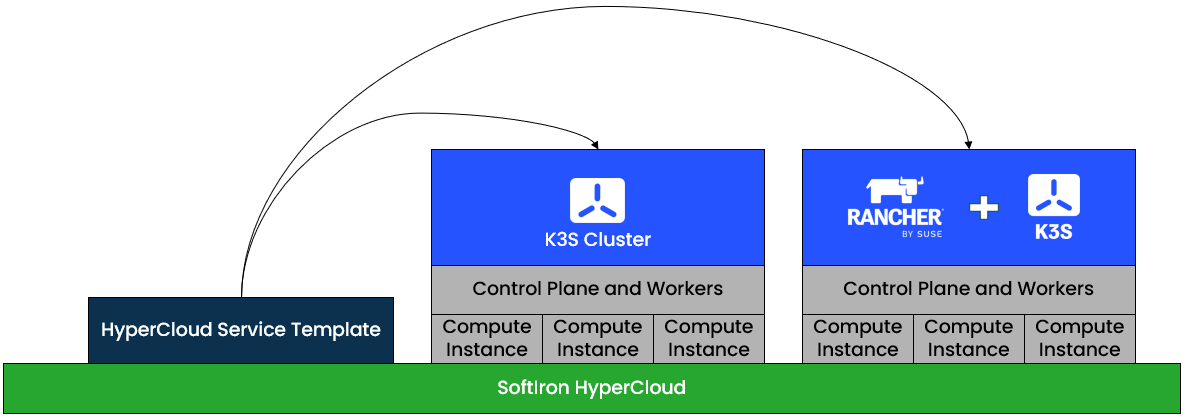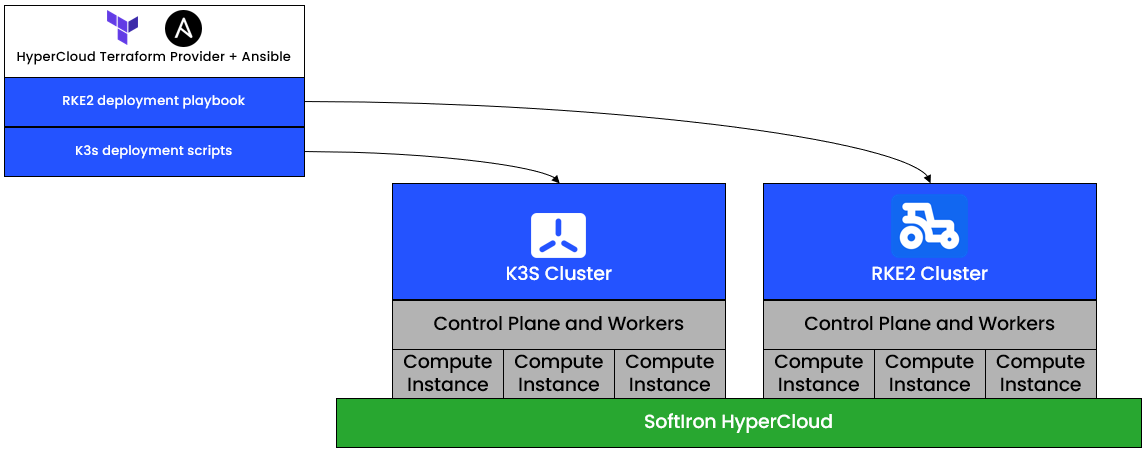Revolutionizing Cloud Infrastructure: A Comprehensive Approach to Streamlined Deployment and Management
SUSE guest blog authored by:
Pedro Álvarez Piedehierro, Software and Systems Engineer at SoftIron

The current era of digital transformation is powered by innovative technologies that rewire business operations, introduce new revenue streams, and facilitate competitive differentiation. As cloud computing becomes an increasingly indispensable component of this tech-driven era, businesses often grapple with the complexity of deploying cloud infrastructure. This is where SoftIron’s HyperCloud, combined with SUSE’s SLES, K3s, and Rancher, offers a holistic, user-friendly solution, eliminating the need for intricate management processes and deep technical expertise.
Rancher simplifies Kubernetes administration, making it easier to deploy, manage, and scale containerized applications within Kubernetes environments. Of course, there are more than just containerization challenges to solve when scaling a cloud environment. This is where HyperCloud can make all the difference. By using Rancher with HyperCloud, your organization can attain a cohesive Kubernetes ecosystem with numerous deployment options, while addressing the storage, networking and operational challenges to scale faced by modern cloud infrastructure. Read on for more details on the benefits of using Rancher with HyperCloud. Or, skip ahead for the low-down on deploying RKE2 and K3s, integrating Kubernetes with HyperCloud storage, and leveraging available SUSE images in the HyperCloud marketplace.
Embracing Ease in Cloud Infrastructure: Understanding the HyperCloud Advantage
SoftIron’s HyperCloud is a revolutionary platform designed to dispel the complexities associated with traditional cloud deployment. It integrates all essential aspects into a unified, holistic solution, marking a paradigm shift from the multi-layered, component-heavy approach of conventional cloud infrastructure.
HyperCloud offers a single, comprehensive technology for building and running cloud infrastructure. This eliminates the need for a large team of specialized engineers to manage diverse components and software layers. With HyperCloud, organizations can deploy a high-performance, scalable, resilient, and adaptable cloud infrastructure with a much simpler management process.
Enhancing Container Management and Kubernetes Orchestration: The Power of K3s and Rancher by SUSE
SUSE’s Rancher and K3s augment HyperCloud’s capabilities, offering robust tools for container management and Kubernetes orchestration:
- K3s is a leading CNCF-certified lightweight Kubernetes distribution, designed to run in resource-constrained environments, ideal for developers and operators seeking a streamlined, efficient Kubernetes solution.
- Rancher is a complete software stack for teams transitioning to containerized operations, covering everything from Kubernetes cluster orchestration to provisioning an apps catalog for cloud-native applications. The Rancher Prime subscription enables SUSE customers to ensure their workloads and cluster operations with certified support and value-added services.
The HyperCloud Marketplace: Expanding Capabilities and Streamlining Processes
SoftIron’s latest enhancement to the HyperCloud platform is the launch of an integrated marketplace, which is easy to enable and is included with HyperCloud at no additional cost. The Hypercloud marketplace facilitates the easy deployment of third-party applications, including SUSE’s SLES, K3s, and Rancher. This development elevates the seamless, integrated experience that HyperCloud aims to provide, thereby extending the platform’s reach and capabilities.
The HyperCloud Storage Controller: A Powerhouse for scalable on-demand storage
SoftIron’s HyperCloud is the performance engine driving a storage infrastructure. HyperCloud includes a variety of features, such as support for all storage types, hardware acceleration, high-density design, a dedicated control path, zero-touch provisioning, low latency tuning, integrated management, silicon-to-system security, and energy efficiency. These features collectively enhance the performance, capacity, reliability, simplicity, and security of your storage infrastructure.
Unveiling the Multifaceted Customer Value: Use Cases and Benefits
Incorporating SoftIron HyperCloud, SLES, K3s, and Rancher into a unified approach to cloud infrastructure provides customers with several compelling use cases and benefits:
- Simplified cloud deployment: The combined force of HyperCloud, SLES, K3s, and Rancher offers an efficient route to deploying cloud infrastructure, reducing the demand for deep technical know-how and intricate management processes.
- Optimized container management: The HyperCloud CSI Plugin for Rancher simplifies container management. It allows developers and administrators to manage HyperCloud capabilities directly through the Rancher platform. As a result, daily administrative tasks are simplified, allowing teams to manage storage more effectively, leveraging the flexibility of block, object, and file storage protocols in a unified system.
- Access to powerful features: including Cloning, Snapshots, Restores of both Block and File storage from within Kubernetes allowing for streamlined operational processes and enabling GitOps for Storage capabilities.
- Seamless Kubernetes orchestration: The fusion of Rancher’s robust Kubernetes orchestration capabilities and K3s’s simplicity results in a robust, user-friendly solution for managing Kubernetes clusters, particularly beneficial for organizations running containerized applications in resource-restricted environments.
- Streamlined OS Management with SLES: SLES provides a secure and reliable operating system for hosting infrastructure on HyperCloud, enhancing security, reliability, and scalability. It supports the modernization of traditional applications and the development of new applications with containers and Kubernetes. The operating system also simplifies tasks such as patch management, system updates, and security hardening, providing a stable foundation for running cloud infrastructure.
- Reduced Overhead and Enhanced Operational Efficiency: By bringing together the capabilities of HyperCloud, SLES, K3s, and Rancher, organizations can significantly reduce management overhead. The consolidated approach helps businesses streamline their IT operations, optimize resource utilization, and ultimately save costs. This, in turn, frees up the IT team to focus on strategic, value-adding activities, rather than getting bogged down in managing complex infrastructure.
A Trusted Solution for Security-Sensitive Environments
HyperCloud is a security-first private cloud solution, suitable for defense, national security, and government customers. Developed over a decade, its software stack delivers a comprehensive operating, storage, and orchestration system, with successful deployments in highly sensitive environments across Australia, the United States, and other NATO countries.
SoftIron champions a shorter, more resilient, and transparent supply chain and provides an auditable solution to global supply chain security gaps. With its commitment to “designed, not assembled” products, SoftIron brings manufacturing capabilities closer to its customers and integrates its operations within the economies and communities it serves.
The blend of these technologies thus brings a host of use cases and benefits to businesses. It simplifies the complexity of deploying and managing cloud infrastructure, makes container management and Kubernetes orchestration more efficient, and enhances overall operational efficiency. The result is a solution that delivers on all fronts – functionality, security, and simplicity.
Deploying Rancher on HyperCloud
There are multiple ways you can deploy Rancher on HyperCloud depending on your use-case and current infrastructure. You can start with our Rancher service templates for a straightforward deployment. If you’re managing Kubernetes clusters with an existing Rancher cluster, the HyperCloud Node Driver streamlines integration. For more granular control, consider adapting our Terraform examples to install K3s or RKE2, then later importing these into Rancher for efficient management and upgrades.
Service template
Using our official service templates is one of the simplest ways to deploy Rancher if you don’t have one in your organization already. By deploying this template, HyperCloud will instantiate the number of VMs required per role, and will do all the installation for you. VMs will communicate with each other to achieve this.

One advantage of using this method is that later on you can scale up or down the deployment using HyperCloud UI, enabling non technical users to use this as well.
HyperCloud node driver
The HyperCloud Node Driver is a powerful tool for organizations that already have an existing Rancher Cluster and wish to continue using it to manage their Kubernetes clusters. Once integrated into your Rancher cluster, the HyperCloud Node Driver becomes a bridge to seamlessly create Kubernetes clusters, including both RKE1 and RKE2, directly within the HyperCloud platform.

When provisioning a Kubernetes cluster, Rancher communicates with the HyperCloud API to facilitate the creation of all necessary resources, enabling Rancher to access and install the required software components with ease. This integration streamlines the management of your Kubernetes ecosystem, ensuring compatibility and efficiency between Rancher and HyperCloud.
Terraform
Unlock the full potential of HyperCloud’s infrastructure provisioning capabilities with our dedicated HyperCloud Terraform provider. Our comprehensive set of Terraform examples, complemented by Ansible automation, empowers you to effortlessly create, configure, and manage VMs on the HyperCloud platform.
With Terraform providing infrastructure orchestration, and Ansible handling software provisioning and configuration, you can attain fine-grained control over your deployment process. This combination ensures flexibility, reliability, and scalability as you build and manage your Kubernetes clusters. Our provided examples serve as valuable resources to kickstart your deployment, enabling you to tailor your infrastructure and application configuration precisely to your organization’s needs. Harness the potential of Terraform and Ansible to streamline your operations and efficiently deploy K3s and RKE2 on HyperCloud.

HyperCloud CSI Storage Provisioning
Storage deployment with containers was originally a fraught and error-prone task. The administrator needed to link a plethora of containers to a large number of storage locations and do so in a way that was consistent and didn’t inadvertently give containers access to parts of the host that they shouldn’t access. HyperCloud’s CSI driver enables easy provisioning of storage on-demand as the application requires it. CSI drivers automate the creation, mounting and securing of storage volumes to reduce complexity and improve performance and security.
- Control storage from manifests just like your Pods and Deployments
- Application-controlled, on-demand storage provisioning
- Storage automatically mounted where the Pods request it
- Automated storage expansion
- Automatic cloning of volumes
- Snapshot and restore directly from Kubernetes
- Block volumes as well as file system volumes
Easily provision both file and block storage to Kubernetes applications in RKE2 and K3S clusters. Enhance your application administration with access to functionality like volume cloning, as well as snapshot and restore, for data protection and workload migrations.

- Storage tasks are represented in Kubernetes using Resource types. A resource can represent the request for a Persistent Volume, or even a cloning task or a snapshot.
- When a Persistent Volume is required the application developer creates a Persistent Volume Claim object detailing the desired volume.
- Submitting this resource to the API server triggers a reconciliation loop and Kubernetes starts to determine how to best serve the request.
- Because the HyperCloud CSI driver is registered and can perform the requested functions the request is sent to HyperCloud.
- HyperCloud creates the Volume as required and passes the details back to the HyperCloud CSI driver
- Kubernetes API server stores the details in a Persistent Volume object and links that Persistent Volume to the Persistent Volume Claim which was originally submitted.
- That request is now delivered, the storage is bound to the underlying volume and is ready for use in a container application.
The result is a solution that delivers on all fronts – functionality, security, and simplicity
In conclusion, the combined value proposition of SoftIron’s HyperCloud, SUSE’s K3s and Rancher, and the powerful HyperCloud CSI Plugin simplifies cloud infrastructure deployment and management while enhancing operational efficiency. With a focus on streamlined processes, improved performance, and secure operations, these solutions equip businesses to harness the full potential of cloud technologies in today’s digital landscape.
To learn more about the benefits of our joint stack and how we can help you get started, please contact the SoftIron team and contact the SUSE team to evaluate your deployment requirements and needs.
Author: Pedro Álvarez Piedehierro, Software and Systems Engineer at SoftIron
 Pedro is a senior software engineer at SoftIron, working on cloud product engineering. His background is in Linux-based platforms and embedded devices and his areas of interest include infrastructure, open source, build systems, and systems integration. He is passionate about automation and reproducibility and is a strong advocate of open-source principles. Pedro is always eager to lend a helping hand and share his knowledge, particularly around DevOps and Integration.
Pedro is a senior software engineer at SoftIron, working on cloud product engineering. His background is in Linux-based platforms and embedded devices and his areas of interest include infrastructure, open source, build systems, and systems integration. He is passionate about automation and reproducibility and is a strong advocate of open-source principles. Pedro is always eager to lend a helping hand and share his knowledge, particularly around DevOps and Integration.
Related Articles
Jul 14th, 2022
‘Contain’ your excitement: The s3gw is in town
Nov 22nd, 2022